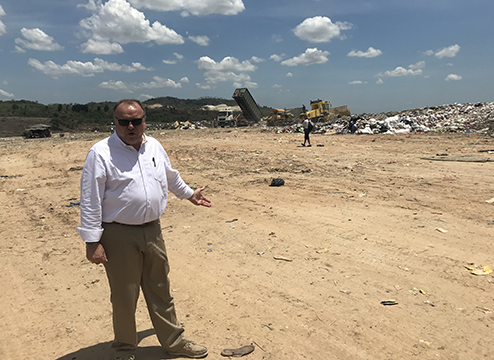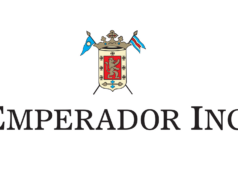(TRASH. Holger Holst stands on top of the active Landfill cell unmindful of the overpowering stench and swarming flies. Photo by Ashley Manabat)
CAPAS, Tarlac – The mounting garbage from all over the region could be the key in converting waste into energy soon at the sanitary landfill in Barangay Kalangitan here.
During a press conference after a site inspection here on Thursday, the Metro Clark Waste Management Corp. (MCWMC), which has been in operation since 2002, said it is now planning to acquire a facility that will convert its waste into electricity as the number of cities and municipalities dumping garbage into the landfill continues to multiply.
“We hope we can develop this task in the next two to three years but it needs another three years to completely develop such a facility to be in operation,” said Holger H.
Holst, a German engineer that is overseeing the operations of the MCWMC as its managing director.
But Rufo Colayco, MCWMC president/ CEO, said the company needs to settle first some “regulatory issues with the government” for the establishment of such a facility.
Colayco said the P500-million MCWMC is now servicing 90 municipalities, excluding big companies, in its present 100-hectare facility – 70 hectares for landfill and 30 hectares for buff er zone.
He said MCWMC is now working on a 17-hectare cell which costs P120 million.
A five-hectare cell before that costs P80 million and another P300 million for site development alone, he added.
“In the very early stages we were buying used equipment in Subic, but now we are buying brand new equipment. It’s more expansive but more reliable,” Colayco said.
He said MCWMC has also acquired the biggest waste compactor in the Philippines which cost P22 million.
“You know the difference, before careless truck drivers get mired in the wet garbage because their trucks straddle one side which is soft and one side on the road which is denser. We had some serious damage with trucks toppling over,” Colayco said gesturing with his hands.
“Now with the compactor, the garbage is so solid, it’s hard and that also lengthens the life of the landfill because you can pack in more garbage,” he explained.
No road But Colayco lamented that Clark (Clark Development Corp.) never paved the Capas road. “But even if they had done that, we would probably still build our own road,” he said.
“The issue would be one of safety and inconvenience on the part of the townsfolk as more and more trailers and trucks carrying garbage continue to pass. You can imagine how annoying it can be for the townsfolk,” Colayco said.
“And from our view point, we don’t want to have to deal with a child having been hit by a truck, that sort of thing. It’s much better for us to have our own private road,” he explained.
“But that would cost easily several hundred millions.” Colayco said the private road will be constructed from MacArthur Highway to the MCWMC site.
“Fortunately, the BCDA (Bases Conversion and Development Authority) is now building an exit at SCTEx which will end up at MacArthur Highway which is very near where our road will start. So hopefully, in the future, we will have a better ability to acquire a much larger tonnage from places like Metro Manila because the garbage trucks can run very efficiently over NLEx, SCTEx and that very efficient exit and onto our private road which is about 5.5 kilometers which is shorter than the seven-kilometer Capas road,” he explained.
Holst said the tipping fee (now at P600-P800 per ton) will not go up if the planned road upgrade and power plant acquisition will be realized even if the investment in the power plant will be around $200 million because “with the generation of power you gain a lot of money.”
But Holst said “it’s not cheap power. You need the waste management fees to, at the end of the day, subsidize the power plant to run it.”
Holst explained that the costs for waste management disappear, “that’s the green virtues but it’s technically impossible. It’s an investment that you need very clear conditions to start it.”
The sanitary landfill here is part of the more than 30,000 hectares in the Clark special economic zone where 9,500 hectares is being developed as the New Clark City.





